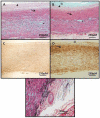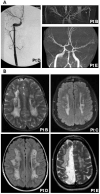De novo ACTA2 mutation causes a novel syndrome of multisystemic smooth muscle dysfunction
- PMID: 20734336
- PMCID: PMC3573757
- DOI: 10.1002/ajmg.a.33657
De novo ACTA2 mutation causes a novel syndrome of multisystemic smooth muscle dysfunction
Abstract
Smooth muscle cells (SMCs) contract to perform many physiological functions, including regulation of blood flow and pressure in arteries, contraction of the pupils, peristalsis of the gut, and voiding of the bladder. SMC lineage in these organs is characterized by cellular expression of the SMC isoform of α-actin, encoded by the ACTA2 gene. We report here on a unique and de novo mutation in ACTA2, R179H, that causes a syndrome characterized by dysfunction of SMCs throughout the body, leading to aortic and cerebrovascular disease, fixed dilated pupils, hypotonic bladder, malrotation, and hypoperistalsis of the gut and pulmonary hypertension.
Copyright © 2010 Wiley-Liss, Inc.
Figures



References
-
- Adès LC, Davies R, Haan EA, Holman KJ, Watson KC, Sreetharan D, Cao SN, Milewicz DM, Bateman JF, Chiodo AA, Eccles M, McNoe L, Harbord M. Aortic dissection, patent ductus arteriosus, iris hypoplasia and brachytelephalangy in a male adolescent. Clin Dysmorphol. 1999;8:269–276. - PubMed
-
- Fatigati V, Murphy RA. Actin and tropomyosin variants in smooth muscles. Dependence on tissue type. J Biol Chem. 1984;259:14383–14388. - PubMed
-
- Gerthoffer WT. Actin cytoskeletal dynamics in smooth muscle contraction. Can J Physiol Pharmacol. 2005;83:851–856. - PubMed
-
- Graf MH, Jungherr A. Clinicopathologic reports, case reports, and small case series: congenital mydriasis, failure of accommodation, and patent ductus arteriosus. Arch Ophthalmol. 2002;120:509–510. - PubMed
Publication types
MeSH terms
Substances
Grants and funding
LinkOut - more resources
Full Text Sources
Medical
Molecular Biology Databases
Miscellaneous

